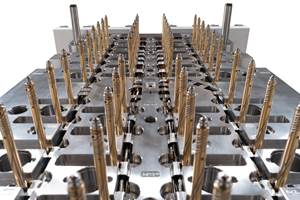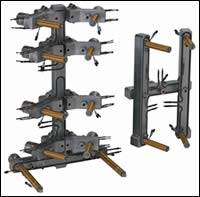How Lean Manufacturing Can Help Your Mold Shop
Rations, a moldmaker stands to save significant money in the long run by incorporating lean manufacturing into daily operations.
Lean is a manufacturing philosophy that shortens the leadtime between a customer order and the shipment of the parts ordered by the elimination of all forms of waste. Lean helps firms in the reduction of costs, cycle times and non-value-added activities, thus resulting in a more competitive, agile and market-responsive company.
A definition of lean used by the Manufacturing Extension Partnership - which is part of the National Institute of Standards and Technology (NIST) (Gaithersburg, MD), a part of the U.S. Department of Commerce - is "a systematic approach in identifying and eliminating waste (non-value-added activities) through continuous improvement by flowing the product at the pull of the customer in pursuit of perfection."
A planned, systematic implementation of lean leads to improved quality, better cash flow, increased sales, greater productivity and throughput, improved morale and higher profits.
Why the Emphasis on Lean Now?
Some of the reasons why lean manufacturing is especially important today as a winning strategy are (1) to compete effectively in the global economy, (2) pressure from customers for price reductions, (3) fast-paced technological changes, (4) continued focus by the marketplace on quality, cost and on-time delivery, (5) quality standards such as QS-9000 and the new ISO 9000:2000, (6) Internet auctions, (7) OEMs holding on to their core competencies and outsourcing the rest, and (8) higher and higher expectations from customers.
To compete in today's economy, you need to be at least as good as any of your global competitors, if not better.
Brief History of Lean
Most of the lean concepts are not new. Many of them were being practiced at Ford during the 1920s, or are familiar to most industrial engineers .
A few years after the Second World War, Eiji Toyoda of Japan's Toyota Motor Company visited the American car manufacturers to learn from them and to transplant U.S. automobile production practices. With the assistance of Toyota's Taiichi Ohno and Shigeo Shingo, he introduced and continuously refined a system of manufacturing whose goal was the reduction or elimination of non-value-added tasks (for which the customer was not willing to pay).
The concepts and techniques that go into this system are now generally known as T.P.S. or Toyota Production System, and were reintroduced back into America in the last few years under the umbrella of "Lean Manufacturing."
Lean concepts are applicable beyond just the shop floor. Companies have realized great benefit by implementing lean techniques in the office functions of manufacturing firms, as well as in purely service firms such as banks, hospitals, restaurants, etc. Lean manufacturing in this context is known as "Lean Enterprise."
The American Society for Quality (ASQ) (Milwaukee, WI) - a leading quality improvement organization in the United States for more than 50 years - has seen a steady increase in the demand among its members about lean, as evidenced by the attendance and interest in lean offerings at its Annual Quality Conference. ASQ recently approved a new interest group titled Advanced Manufacturing Interest Group (AMIG) for members to participate in lean-based activities. Similar interest is seen by Society of Manufacturing Engineers, Association for Manufacturing Excellence, etc.
The Wastes of Lean
There are eight "wastes" (or muda in Japanese) associated with lean:
- Overproduction - Making more, earlier or faster than is required by the next process.
- Inventory waste - Any supply in excess of a one-piece flow through the manufacturing process, whether it is raw materials, work-in-process or finished goods.
- Defective product - A product requiring inspection, sorting, scrapping, replacement or repair.
- Over-processing - An effort that adds no value to the product or service from the customer's point of view.
- Waiting waste - Idle time created waiting for manpower, materials, machinery, measurement, information, etc.
- People waste - The waste of not fully using people's abilities (mental, creative, skills, experience, etc.).
- Motion waste - Any movement of people (or tooling/equipment) that does not add value to the product or service.
- Transportation waste - Transporting parts or materials around the plant.
You can eliminate waste by identifying and purging all non-value-added activities. Waste is any activity that does not add value to the final product for the customer. A value-adding activity is an activity that transforms or shapes raw material or information to meet customer requirements. Approximately five percent of total work/ time is considered a value-added activity.
In contrast, a non-value-adding activity is an activity that takes time, resources or space, but does not add to the value of the product itself - which is approximately 70 percent of work/time. In addition, there is non-value-adding but necessary - accounting, governmental regulations, etc. - that makes up approximately 25 percent of work/time.
The major objective of lean implementation is the continuous reduction/elimination of these eight wastes.
The Building Blocks of Lean
The tools and techniques used in the introduction, maintenance and improvement of the lean system are sometimes referred to as the lean building blocks. These building blocks make up the "House of Lean".
These blocks include:
- 5S - A system for workplace organization and standardization.
- Visual controls - The placement in plain view of all tooling, parts, production activities and indicators so that everyone involved can understand the status of the system at a glance.
- Streamlined layout - Plant layout designed according to optimum operational sequence.
- Standardized work - Consistent performance of a task, according to prescribed methods, without waste, and focused on human movement.
- Batch size reduction - The best batch size is one-piece flow - or make one and move one. If one-piece flow is not appropriate, reduce the batch to the smallest size possible.
- Teams - In the lean environment, the emphasis is on working in teams, whether it be improvement teams or daily work teams.
- Quality at the source - Inspection and process control by the operators so that they are certain that the product that is passed on to the next process is of acceptable quality.
- Point of use storage - Raw material, parts, information, tooling, work standards, procedures, etc., are stored where needed.
- Quick changeover - The ability to change tooling and fixtures rapidly (usually in minutes) so that multiple products in smaller batches can be run on the same equipment.
- Pull/Kanban - A system of cascading production and delivery instructions from downstream to upstream activities in which the upstream supplier does not produce until the downstream customer signals a need (using a Kanban system).
- Cellular/flow - Physically linking and arranging manual and machine process steps into the most efficient combination to maximize value-added content while minimizing waste. The aim is single-piece flow.
- Total productive maintenance - A lean equipment maintenance strategy for maximizing overall equipment effectiveness.
Besides the building blocks mentioned above, there are other concepts or techniques that are equally important in lean: Value Stream Mapping (VSM), Just-In-Time (JIT), Error Proofing (poka-yoke), Autonomation (jidoka), Continuous Improvement (Kaizen), Kaizen Blitz1 for breakthrough improvements, Change Management, etc.
Also, three essential ingredients for successful lean implementation are: (1) sustained, disciplined commitment from senior management; (2) training in the lean building blocks for all employees; and (3) good "cultural" change management. Lean will not work if it is viewed as merely a project for point solutions, or as a vehicle for downsizing. It works best if deployed as a never-ending philosophy of continuous improvement.
How to Start the Lean Journey
The starting point of lean initiatives could be any one of the following:
- Lean base-line assessment - Using interviews, informal flow-charting, process observations and analysis of reliable data, an "as-is" situational report can be generated from which would flow the lean improvement plan based on "gaps."
- Value Stream Mapping (VSM) - A set of specific actions required to bring a product family from raw material to finished goods per customer demand, concentrating on information management and physical transformation tasks. The outputs of a VSM are a Current State Map, Future State Map and Implementation Plan to get from the current to the future state.
- Start by providing "massive" training in lean to a critical mass of employees in "teach-do" cycles.
- Begin by implementing the "basic" building blocks first: 5S, Visual Controls, Streamlined Layout, Point of Use Storage, Standardized Work, etc.
- Pilot Project - Choose a bottleneck area to do breakthrough lean improvement (use the Kaizen Blitz approach). Then, with the lessons learned, migrate to other areas.
- Change management - Align the company's strategies and employee's goals, then change the culture from the traditional "push" production to lean "pull." This should result eventually in a philosophical change in people's daily work life.
- Start by analyzing the internal Overall Equipment Effectiveness (OEE) and the OEE losses; a prioritized ranking of these losses will identify the "biggest bang for the buck" to indicate where to start the lean journey.
How to Sustain Lean?
Several steps can help sustain lean:
- Internalize it into daily work.
- Realize that it is a never-ending process or philosophy.
- Provide discipline/motivation/incentives.
- Maintain continued, visible management commitment.
- Open communication channels.
- Standardize so as not to slip back.
- Promote the role of lean champions.
- Feature job rotation.
Starting the lean process is comparatively easy; but sustaining it over the long haul takes robust planning, discipline, commitment, patience, trial and error, a good reward and recognition program and people's receptivity to change and growth.
REFERENCES
1Term service - marked by the Association for Manufacturing Excellence.
Acknowledgement: Some of the concepts presented here are in a format derived from the lean effort by the Manufacturing Extension Partnership (MEP). Its website is www.mep.nist.gov.
Related Content
How to Solve Hot Runner Challenges When Molding with Bioresins
A review of the considerations and adaptations required to design hot runners and implement highly productive injection molding operations.
Read MoreHands-on Workshop Teaches Mold Maintenance Process
Intensive workshop teaches the process of mold maintenance to help put an end to the firefighting culture of many toolrooms.
Read MoreMaking Quick and Easy Kaizen Work for Your Shop
Within each person is unlimited creative potential to improve shop operations.
Read MoreThe Role of Social Media in Manufacturing
Charles Daniels CFO of Wepco Plastics shares insights on the role of social media in manufacturing, how to improve the “business” side of a small mold shop and continually developing culture.
Read MoreRead Next
Lean Manufacturing Trims Leadtimes
Moldmakers aren't the only ones reducing leadtimes. Component and hot runner suppliers are delivering their equipment and supplies faster to accommodate industry demand.
Read MoreReasons to Use Fiber Lasers for Mold Cleaning
Fiber lasers offer a simplicity, speed, control and portability, minimizing mold cleaning risks.
Read MoreHow to Use Strategic Planning Tools, Data to Manage the Human Side of Business
Q&A with Marion Wells, MMT EAB member and founder of Human Asset Management.
Read More



















